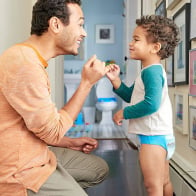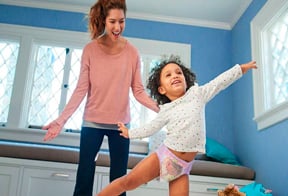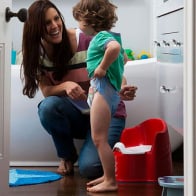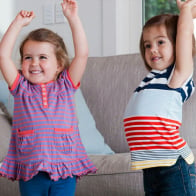There are a lot of ideas about how to potty train out there. And some of them such as infant potty training — also known as the “traditional method” of potty training or “elimination communication” — can leave parents wondering if they’re starting too late or missing out on a proven method. So how do you know what’s the right potty training method for your child?
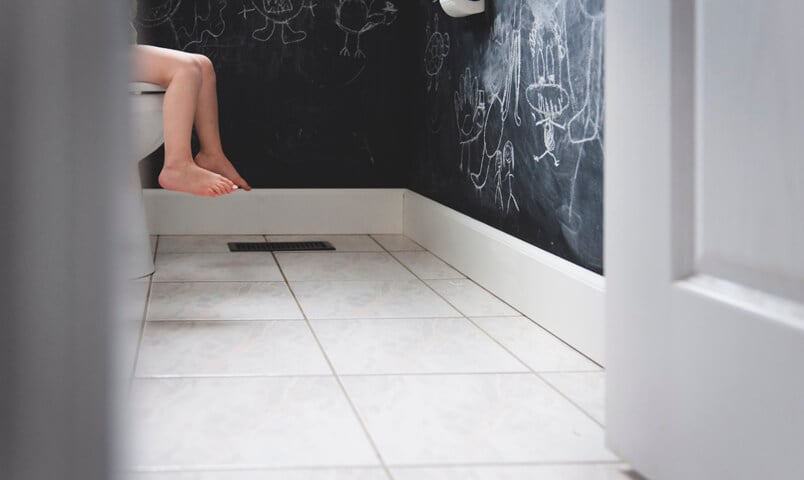
What Is Elimination Communication?
Getting your child toilet trained that early probably sounds ideal, right? Well, to do it you’d need to be at your baby’s side 24 hours a day, 7 days a week. That simply isn’t realistic for many families today. And even if you taught your baby to release their bladder and bowel contents on cue, you’d still need to teach them the full routine of going to the toilet on their own when they became a toddler.
Signs Your Child Is Ready For Toilet Training
- Pulling at a wet or dirty diaper.
- Hiding to pee or poop.
- Showing interest or copying the behavior of people who are using the bathroom.
- Staying dry in their diaper for longer than usual.
- Waking up dry from a nap.
- Telling you that they’re about to go or have just gone.
Create Your Toilet Training Plan
- Be flexible. Don’t set deadlines such as a certain date or age for having a fully potty trained child. It takes time, and every child progresses at a different stage. While some kids train quickly and easily (of course, that’s what we all wish for!), some kids take more time and just aren’t interested as early.
- Start introducing the idea. Potty training doesn’t start the first day your child sits on the toilet. It begins with little steps such as talking to your child about the bathroom and demonstrating how it works. Remember that even if you have the best intentions your child won’t be potty trained until they’re ready.
- Get your potty training tools. Think about the gear you’ll need to begin potty training:
- Step stool. A toilet can be a big climb for little toddler legs, so get a sturdy step stool.
- Toilet seat. A child-size toilet seat that sits on top of your regular seat can be really helpful too, so kids aren’t afraid of falling in or uncomfortable while they’re waiting for the pee or poop to come.
- Potty chair. Some families prefer to start with a potty chair instead of the big toilet, or they buy a potty chair to place in a playroom or other often-used space so kids have quick access when they need to go.
- Pull-Ups® training pants. Pulling their own pants up and down is a big part of learning to use the potty like a Big Kid. Pull-Ups® training pants make this easy and also help make an important distinction between diapers and how Big Kids dress.
- Consider your lifestyle. If your child goes to daycare, think about when you have the most time together, such as a weekend, to start potty training. Also, choose a time when you’ll be home. It’s much easier for kids to learn to use the potty at home than when they’re out running errands with you, attending a birthday party or taking a family trip.
- Demonstrate bathroom tasks. Before you officially start potty training, encourage your child to practice tasks one at a time, such as pulling down their pants, sitting on the potty and wiping. As you’re planning the potty training method that will work best for your family, remember that kids love to mimic their parents. Try this Can You Do What I Do? potty training game as part of your training plan.
- Talk about the urge. To be ready to potty train, kids need to recognize when they need to go. Demonstrate this by telling them when you have the urge and talking about what that feels like.
- Point out potties. When you’re out grabbing groceries, visiting friends or at Grandma’s house, point out all the other spots where your child can find a toilet. They might not realize that potties are available in far more places than your house. You can practice beforehand with the downloadable Find the Potty potty training game.
- Think about rewards. You know your child best. What makes them feel good? Are words of praise and encouragement the fuel that will drive them in this potty training process?
- Will inexpensive little gifts motivate them? Or will having a sticker chart that demonstrates successes make them feel proud? Make fun potty training part of your routine.
